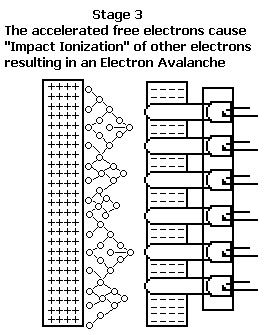Great Posts!
From my most recent research:
It seems the purpose of the Gas Processor is to create a "Electron Cascade".
On the LED's. I honestly don't believe their purpose is to excite the Oxygen atoms when they are in a high enough voltage field to bring the electrons all the way to ionization. To me it seems that they are used to increase the efficiency of the electron cascade that is taking place.
Photon Assisted Electron Cascade?
Chasson321, a few posts back you posted an interesting paper, there I found what I always believed, on page 3. The answer to question (#3c) was:
To me it seems once again we can find things that are similiar to Meyers Gas Processor. Like Photomultiplier Tubes (Gas Ionization Tubes) which create a Electron cascade which produces current, the current produced is used on a low voltage circuit and measured for a variety of purposes. (Interesting how very similiar it is to the GP as it has a different form of an Electron Extraction Circuit)
Photomultiplier - Wikipedia, the free encyclopedia
Techniques for nuclear and particle ... - Google Books
On the second link it is explained that photomultipliers can use either a continuous voltage or a pulsed voltage.
And I'm sure as you all have seen the Gas Processor Circuit, if you understand it, you'll understand that the higher the voltage the engine sensing devices output (RPM, Laser Accelerator) the more electrons will be consumed in the Electron Extraction Circuit, controlling the amount of energy produced in the cylinders of the engine!
From my most recent research:
It seems the purpose of the Gas Processor is to create a "Electron Cascade".
On the LED's. I honestly don't believe their purpose is to excite the Oxygen atoms when they are in a high enough voltage field to bring the electrons all the way to ionization. To me it seems that they are used to increase the efficiency of the electron cascade that is taking place.
Photon Assisted Electron Cascade?
Chasson321, a few posts back you posted an interesting paper, there I found what I always believed, on page 3. The answer to question (#3c) was:
Electrical energy raises electrons in the gas atoms to a higher energy level....
Photomultiplier - Wikipedia, the free encyclopedia
Techniques for nuclear and particle ... - Google Books
On the second link it is explained that photomultipliers can use either a continuous voltage or a pulsed voltage.
And I'm sure as you all have seen the Gas Processor Circuit, if you understand it, you'll understand that the higher the voltage the engine sensing devices output (RPM, Laser Accelerator) the more electrons will be consumed in the Electron Extraction Circuit, controlling the amount of energy produced in the cylinders of the engine!


 for with that knowlegde you can run an engine provided you use a Gas Processor(GP) in tandam with the three different systems talked about for you will not get much energy content without the GP doing it's job.
for with that knowlegde you can run an engine provided you use a Gas Processor(GP) in tandam with the three different systems talked about for you will not get much energy content without the GP doing it's job. .
.








Comment